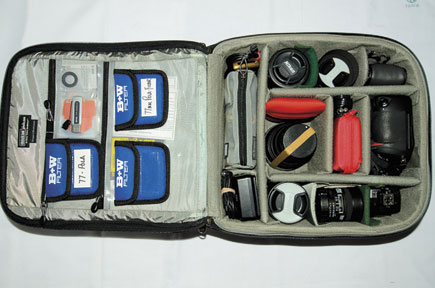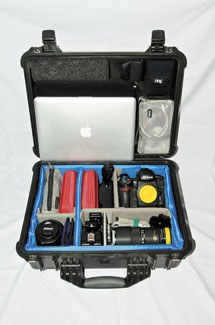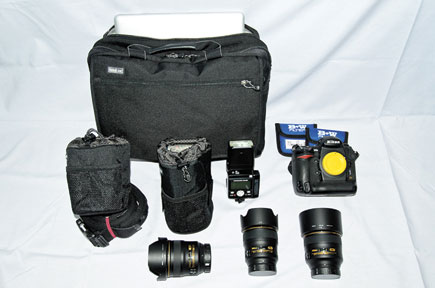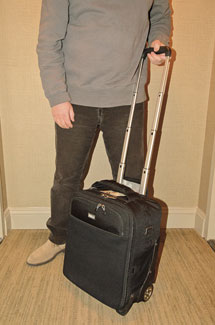Flight Plans; Remove Your Shoes, Your Belt, Your AA Batteries
I’m writing this in mid-December as I’m making plans for a February trip to Vietnam. As those plans are shaping up, it might be a good time to talk about how I decide what to take on my photo trips and how I try to ease it all through the world’s airports.
The gear I take depends on where I’m going, how long I’ll be there, and what I expect to accomplish. One thing I know from the start: not all trips are the same, so there’s no one bag or case that’s perfect for all purposes. What I carry my gear in depends very often on how I’ll be traveling. If I’m going to be bouncing around in four-wheel-drive vehicles, the trip’s going to be rough on my equipment, so I’ll take a rugged Pelican 1500 case or two for my location work. Lately, though, I’ve been using a Think Tank case called the Airport AirStream. It’s a rolling carryon that’s obviously well within US airlines’ carryon classifications and regulations. But what’s great about it is that it also fits the carryon requirements of the small, regional airlines I often have to take in the countries I travel to; regular rolling cases often won’t fit in the overhead bins on those planes.
 |
||
|
||
When I get on the plane I’ll be carrying either the AirStream or the Pelican and a shoulder bag—lately it’s a Think Tank bag designed not to look like a camera bag; in fact, it’s called the Urban Disguise 60. In it will be a belt and a few pouches, in which are my main camera body, two or three of my workhorse lenses, and one flash (often the pouches will carry the gear I’ll need for a day’s shooting at my destination). A big plus for the Urban Disguise is that it also has a compartment for my laptop and a portable hard drive.
If I don’t think I’ll need the pouches—if, say, I’ll be working mostly in cities—I’ll take my Billingham Large Hadley bag rather than the Urban Disguise and work out of it on the city streets.
 |
||
|
||
The big question is always, light or heavy? If I’m going to be doing a lot of climbing and hiking out in hilly terrain or forests or a desert, light is the obvious choice. What’s light? Two cameras, four to six lenses—I carry mostly primes, not zooms—and two flashes. If I’m going to be mostly in populated areas—marketplaces, cities, farming communities—and working close to people, as I will in Vietnam, I know the longest lens I’ll need will be my 180mm, so I’ll bring it along with my 24, 35, and 85mm, plus two flashes and two camera bodies.
Sometimes I’ll go with a laptop, sometimes not, depending on the length of the trip, how I’ll be traveling within the country, and how accessible electricity and the Internet is. A complete back-up kit can include portable hard drives (I like LaCie, WiebeTech, and Glyph units); if I’m going light, I’ll skip the laptop and drives and go with Epson P-5000 battery-powered digital wallets.
Though the gear and how to transport it are important considerations, the main issue for me is getting to the various locations as smoothly as possible, and that means getting the gear through airports.
In my experience, no airport security station is going to be satisfied with only an x-ray of my carryons; my bags and cases are almost always opened and inspected. I expect that, so I get to the airport early; the biggest cause of aggravation is time pressure.
 |
||
|
||
It’s no news to you that some airports are better than others when it comes to the speed, courtesy, and efficiency of their security procedures. Particularly tough is London’s Heathrow. I’m not complaining about the thoroughness of their security checks—that’s fine; but they can be very difficult about determining the exact weight and size of whatever you carry on the plane. I’ve had instances of having to take items out of a carryon and put them in the photo vest I was wearing in order to comply with their exacting weight limits. I know photographers who’ll take the Chunnel and fly from Paris in order to avoid Heathrow.
The most interesting airports are the ones in India. Sometimes it seems that all the security people working at Indian airports are into photography. They spend a lot of time taking everything out, looking it over, and, often, chatting with me about the equipment. One thing I learned early on: in India you’re not allowed to keep AA batteries in any of the gear, so I make sure I’ve taken them out and stored them separately in a clear plastic container in the carryon.
The best tip I can give you when it comes to airport security is this: make it easy for the airport security people and you make it easier for yourself. Everything I carry conforms to carryon regulations. I make sure that when the security personnel open the cases everything is neatly placed. There’s no jumble of gear, no snarl of wires, cords, and cables. A tidy layout for the portable hard drives or the digital wallets, the batteries, memory cards, chargers, cameras, lenses, and flash units makes it easy for them—and for me when I have to put everything back into the case after all the gear has been removed and examined. To help me with that, years ago I got into the habit of taking a Polaroid picture of my packed camera cases and bags so I’d have no question about the layout when I had to repack. Digital has replaced Polaroid, and a printout of the digital photo of the layout is right there, in the bag, just like the Polaroid used to be.
 |
||
|
||
By the way, my mention of cords, cables, and chargers was deliberate. Don’t put them in checked baggage; carry them with you if possible. If your checked bag goes astray, you don’t want the chargers and cords to be lost with it.
I carry contact information for the people who insure my cameras (a company called Taylor & Taylor; they’ve been working with photographers for years) and names and numbers for Foto Care, the camera store I deal with in New York City. In case anything is damaged or lost, they can quickly ship a replacement.
The final thing I carry: everything I’ve learned from other photographers who talk about their travel experiences, provide advice, and share valuable information on two blogs I keep up with: http://boardingarea.com/blogs/flyingwithfish and www.lightstalkers.org. You might want to check them out if you’ll be checking in at an airport gate any time soon.

















































